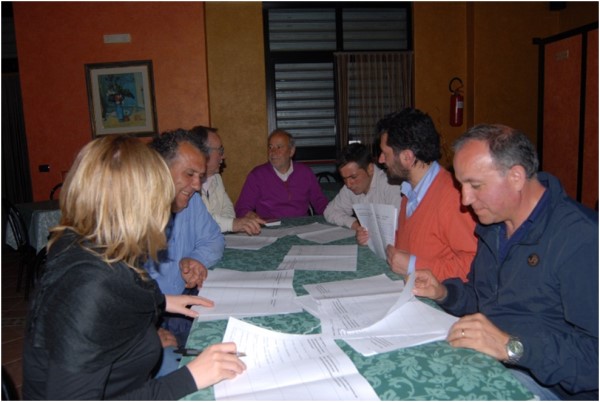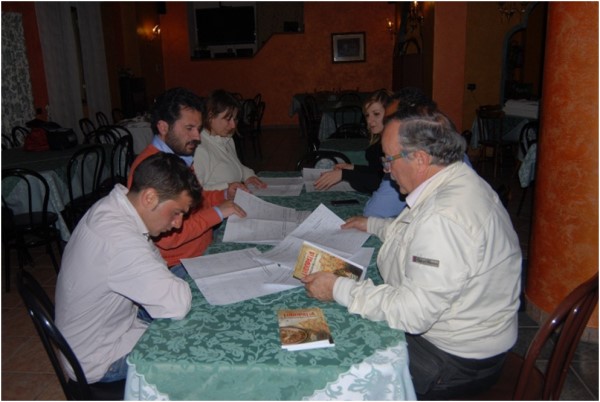| Authors: | Cecelia De Ita, Lindsay Stringer, Luuk Fleskens, Andy Dougill, with input from study sites |
| Editor: | Jane Brandt |
| Source document: | De Ita et al. (2015) Report on stakeholder adaptation strategies in the CASCADE study sites. CASCADE Project Deliverable 8.1. |
Stakeholders in Italy perceived changes in the weather, wildfires, loss of vegetation and soil erosion. In Castelsaraceno, 18 drivers of change were identified by stakeholders. The changes perceived were largely water-related and driven by climatic events such as reduction in rainfall and surface water changes. Changes in vegetation, pests and in traditional grazing and agriculture were also noted. Changes at higher altitudes were particularly worrying for stakeholders. As a local naturalist expressed: “there is a progressive deterioration of grass cover on pasture land at higher altitudes and evident processes of erosion are manifesting increasingly year by year. I have even found numerous prehistoric artefacts in areas of heavy erosion”.


It is interesting to note that land users (farmers and shepherds) did not mention climatic events as drivers of change. Instead, they tended to focus on human drivers, such as changes in agricultural and farming practices, water consumption and other environmental management practices.
Stakeholders in Italy proposed a total of 26 adaptation measures, of which almost half were measures towards environmental management and innovation/ alternative practices, and a third were cultural, as they aimed to train the next generation in areas such as farming and tourism, and generally to promote culture.
Table: Changes identified by stakeholders in Castelsaraceno, Italy.
| Drivers of change | Government representative | NGO | Sedentary land manager | Transient land user | Hunter association | Other local expert |
| Climate change | X | X | X | |||
| Concentration of rainfall in short periods | X | |||||
| Human use of spring water/reduced water availability | X | X | ||||
| Changes in agricultural/farming practices | X | X | X | X | ||
| Overgrazing | X | X | ||||
| Oil extraction | X | |||||
| Pests | X | |||||
| Reduction/ abandonment, cultivation and/or farming | X | |||||
| Pollution | X | X | ||||
| Changes in agricultural and/or farming practices | X | X | X | X | X | |
| Lack of environmental and infrastructure management | X | X | X | |||
| Environmental protection | X | |||||
| Other economic activities (industrialization) | X | X | ||||
| Policy incentives to cut vineyards | X | |||||
| Lack of environmental and infrastructure management | ||||||
| Lack of regard for nature | X | |||||
| Lack of generational change | X | X | X | |||
| Lack of support for farming | X | X | X |
During the focus group, perceptions of future changes highlighted incremental variations in climatic changes, a decrease of water flow and increase in flooding, an increase in changes to vegetation such as “the death of some traditional tree species at higher altitudes”, and subsequent changes to wildlife. However there was a divide in the expected changes for land management. Some stakeholders were concerned that “The total deactivation of agriculture and livestock farming with the eventual abandonment of the territory (depopulation) as there will not be a younger generation left to take over” would unfold, while another vision was that there will be a “return to agriculture and livestock farming with new innovations and access to new markets”. The latter view is based on systemic changes and innovations, such as the mechanisation of farms, training of younger generations, promotion and export of local produce, creation of infrastructure and improvements in policy and administration, such as the reduction of bureaucracy and improvements in incentives to farmers. In the Table below, the views of different stakeholders groups about the future changes and management/policies needed can be contrasted.
Table: Summary of future expectations, alternative land management options and policy/economic support required by stakeholder groups in
Castelsaraceno, Italy.
| Stakeholder group | What future regime changes do you expect? | What alternative land management options will you consider? | What policy / economic support is required to facilitate the adaptations and changes you mentioned? |
| Landscape user | • Uncontrollable global warming. • Greater risk to riverbeds and increasingly devastating flooding. • Changes to vegetation. • Reduced productivity of pastures. • Growth of tourism in inhabited areas. • Increase numbers of young people coming into the agricultural sector with the creation of multifunctional farms (with services linked to tourism) • Decrease of tourism in deserted areas |
• Expansion of existing and new forests. • Eco-compatible regime change to water management. • Consideration given to the carrying capacity of grazing areas. • Increased infrastructure and services. • Free use or rental contract of farm land and/or pasture land. |
• Public incentives for use of alternative energy sources. • Abolition of incentives for the search for hydrocarbon deposits. • Incentives for reforestation of public and private areas. • Incentives for innovating local artisanship and traditional land management techniques. • Incentives to promote cultural and recreational activities in the local territory. |
| Land Users | • Disappearance of livestock rearing. • Further migration of young people. • Loss of local traditions. • Desertification. • Invasion of shrublands. • Return to agriculture, livestock farming and shepherding with modern innovations and techniques. |
• Mechanisation of farms. • Installation of solar panels. • Better infrastructure services for people. • Under grazing. • Setting up of cooperatives and associations between local stakeholders and the re-launch of agriculture. • Exporting local produce |
• Incentives and support for the younger generation’s insertion into rural practices. • Creation of the necessary infrastructure for land and livestock farming • Reduction in bureaucracy generally and surrounding re-cultivation and livestock farming. • Regional training for farming, agriculture as well as courses to allow knowledge transfer across generations. • Public servants trained in agricultural and animal husbandry. • Incentives for setting up new farms and agricultural enterprises. • Recognition of local produce and livestock. |
| Government Representative | • Increase in wooded areas. • Changes in the fauna. • Land degradation. • Demographic changes. |
• Return to productive activities compatible with the local territory (agriculture and sheep farming). • Safeguarding of protected areas. • Revision of the waste management policy. • Development of tourism activities locally. |
• Cutting bureaucracy for those wanting to start agricultural activities. • Ad hoc policies for the safeguarding of the local territory. • Cultural investments in local citizens. • Nationalisation of the waste disposal industry. |
| NGO representative | • Increased global pollution. • Changing weather and climate. |
• End to the extraction of petroleum. • State incentives for the use of alternative energy sources. • Creation of voluntary conservation groups. |
• Economic support for training and education. • Support and recognition for volunteers and pensioners. • Incentives for private and public firms to lower their carbon footprint and operate at “zero impact”. |
The expectations for the region are also conditioned to different scenarios in agricultural abandonment. As a local expert stated, “there will be a growth in natural tourism in the areas still inhabited and where agricultural activities have not been abandoned, but [this potential] will decrease in abandoned areas where the landscape is more homogenous and less interesting”.
Note: For an overview results of the workshops on identifying adaptation strategies in all study sites and the concluding recommendations see »Adaptation strategies.
